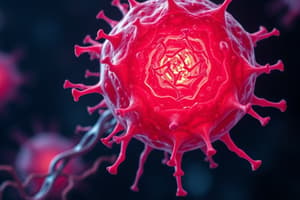Podcast
Questions and Answers
Which of the following is a key characteristic of apoptosis, or programmed cell death?
Which of the following is a key characteristic of apoptosis, or programmed cell death?
- It leads to an inflammatory response in the surrounding tissues.
- It results in the uncontrolled swelling and bursting open of cells.
- It requires energy expenditure by the dying cell to carry out the orderly degradation of cellular constituents. (correct)
- It is a reversible process that can be halted by removing the initial stimulus.
Which of the following is a key feature of neoplasia, or abnormal cell growth?
Which of the following is a key feature of neoplasia, or abnormal cell growth?
- Neoplastic growth is autonomous and exceeds the growth of the normal tissue from which it originated. (correct)
- Neoplastic growth is always reversible if the initial stimulus is removed.
- Neoplasia only refers to the development of benign tumors, not malignant cancers.
- Neoplastic growth is tightly regulated by the surrounding tissues and the body.
Which of the following is a characteristic of necrotic cell death, as opposed to apoptotic cell death?
Which of the following is a characteristic of necrotic cell death, as opposed to apoptotic cell death?
- It leads to the release of cellular contents that can trigger an inflammatory response. (correct)
- It requires active energy expenditure by the dying cell.
- It results in the controlled, orderly degradation of cellular constituents.
- It occurs without any disruption to the surrounding cellular architecture.
Which of the following processes is not a characteristic of rigor mortis, the stiffening of the body that occurs after death?
Which of the following processes is not a characteristic of rigor mortis, the stiffening of the body that occurs after death?
Which of the following is not a characteristic of autolysis, the self-digestion of cells that occurs after death?
Which of the following is not a characteristic of autolysis, the self-digestion of cells that occurs after death?
Which of the following is a key component of the inflammatory response that occurs in response to tissue damage or infection?
Which of the following is a key component of the inflammatory response that occurs in response to tissue damage or infection?
What is the term used to describe uncontrolled cell death in response to injury, where dying cells release injurious enzymes and other factors?
What is the term used to describe uncontrolled cell death in response to injury, where dying cells release injurious enzymes and other factors?
Which of the following statements about necrosis is NOT true?
Which of the following statements about necrosis is NOT true?
Which of the following is NOT a potentially reversible change of cells, provided that the inciting stimuli are corrected?
Which of the following is NOT a potentially reversible change of cells, provided that the inciting stimuli are corrected?
Which of the following statements about inflammation and wound healing is true?
Which of the following statements about inflammation and wound healing is true?
Which of the following is a consequence of hypoxia?
Which of the following is a consequence of hypoxia?
What is the primary role of aerobic metabolism in cells?
What is the primary role of aerobic metabolism in cells?
Which of the following cellular changes is associated with cell injury?
Which of the following cellular changes is associated with cell injury?
What is the primary function of inflammation?
What is the primary function of inflammation?
Which of the following conditions is associated with cervical dysplasia in women?
Which of the following conditions is associated with cervical dysplasia in women?
Which of the following cellular changes is referred to as 'fatty change'?
Which of the following cellular changes is referred to as 'fatty change'?
Flashcards are hidden until you start studying




